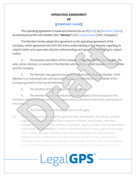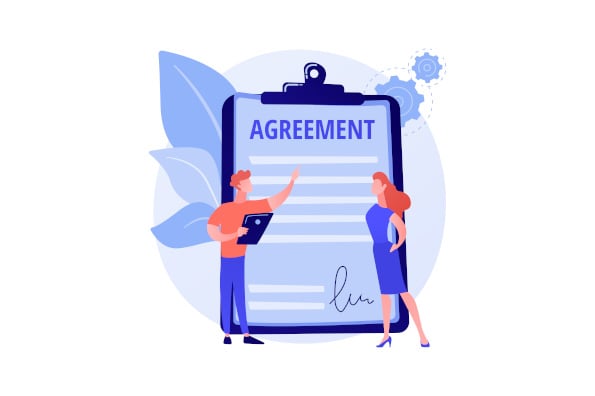Fitness Instruction Waivers: Maximizing Safety—What You Need to Know
If you're a personal trainer or involved within the fitness industry, you know that maintaining a strong reputation and offering a seamless service...
7 min read
LegalGPS : Oct. 8, 2024
Setting up your business is a remarkable achievement. However, as every entrepreneur knows, running a successful venture is about more than just providing quality products or services. One often overlooked aspect of business administration is legal preparedness, and a significant part of this is understanding the necessity for a 'Client Release and Liability Waiver'.


Secure Your Client Liability Waiver Now!
Legal GPS templates are drafted by top startup attorneys and are fully customizable🛠️.
Trusted by 1000+ businesses to close secure deals.
Most of us have come across a release and liability waiver at some point, perhaps without even realizing it. For instance, you sign a waiver before participating in potentially hazardous activities, such as skydiving or entering a construction site. By signing, you agree not to hold the business liable for any hazards inherent in the activity. But do you know why it's relevant to your business?
In simple terms, a client release and liability waiver is a legally binding document that can help shield your business from many forms of liability. If a client or customer sustains an injury or loss connected to your business's operation or services, having a signed waiver on file can limit your legal responsibility and help protect your business in the event of a lawsuit.
Here's why a well-crafted client release and liability waiver should be essential in your business toolkit.
The number one reason for using a release and liability waiver is to help mitigate legal risks associated with your business operations. If a customer suffers a damage or injury while engaging with your business or using your services, they may decide to take legal action against your company. A well-drafted waiver can provide a crucial line of defense in such scenarios.
Lawsuits can be incredibly expensive, even if you eventually win the case. The legal costs, including attorney’s fees, can quickly add up, and these unplanned expenses can threaten your business assets, your reputation, and even your livelihood. Having your clients sign a liability waiver before using your products or services is one way to safeguard your enterprise from such damaging events.
A liability waiver can also serve as a tool for educating consumers about the potential risks involved with a product or service. By outlining the potential risks in the waiver, you're informing your customers on what they should be aware of when using your services or products.
Having a liability waiver can also create a professional image for your business. When clients see you're ensuring all legal bases are covered, it infuses trust and conveys that you're not taking any corners with your business operations and customer safety.
In the unfortunate event of a dispute, having a signed waiver can serve as a point of reference for both parties. The document informs both sides of what was agreed upon before the service was provided, thus facilitating a smoother resolution process.
Having established the importance of a client release and liability waiver, it's equally crucial to understand what makes a waiver effective and legally protective. Here are some key elements that should be included:
Good liability waiver language should be clear and concise, with straightforward terminology. Any ambiguity or complex legal jargon could confuse signers and potentially create legal loopholes.
Your release should provide a specific, detailed description of the activities or services to which the waiver will apply. This ensures that clients are fully aware of the associated risks they're acknowledging.
How to Draft Fitness Instruction Waivers
An effective waiver should include a comprehensive list of potential risks associated with your product or service. This provision not only alerts clients to all possible dangers but also strengthens your business’s protection under the waiver.
Creating a client release and liability waiver may seem overwhelming at first, but by following these simple, actionable steps, you'll master the process in no time. So grab a cup of coffee, and let's dive into how you can draft a solid waiver for your business.
Choose a title for your waiver that clearly and concisely communicates its purpose, such as 'Client Release and Liability Waiver'. In your introductory paragraph, provide a brief overview of the document, including the client's name, your business name, and the nature of the activities or services involved.
**Client Release and Liability Waiver**This Client Release and Liability Waiver ("Agreement") is entered into between [Client's Full Name] ("Client") and [Your Business Name] ("Company"). The purpose of this Agreement is to address the inherent risks associated with [specific activities or services provided by your business]. By signing this Agreement, the Client acknowledges and assumes these risks and agrees not to hold the Company responsible for any injuries, damages, or claims arising from participation in the identified activities or services.Specify the activities, services, or events your waiver covers. Clarity is essential—ensure your clients understand the precise scope of the risks they're agreeing to assume.
##1. Scope of the AgreementThe Client acknowledges that the Company provides [list services, activities, or events your waiver covers]. The Client understands these activities may involve inherent risks, including, but not limited to [list possible risks associated with your business activities].


Legal GPS Pro
Protect your business with our complete legal subscription service, designed by top startup attorneys.
Outline the potential risks associated with the activities or services covered by your waiver, and indicate that the client assumes these risks upon signing the document.
##2. Risks and Assumption of RiskBy signing this agreement, the Client acknowledges the inherent risks involved in [insert your business activities or services], including [list specific risks, such as injury, property damage, or financial loss]. The Client assumes full responsibility for any injuries, damages, or claims resulting from these risks and agrees not to hold the Company responsible.Stipulate that the client releases your business from all liability relating to any injuries or damages arising from their participation, and specify that the client will indemnify and hold your business harmless from any claims.
##3. Release and IndemnificationThe Client, to the fullest extent permitted by law, hereby releases and indemnifies the Company and its employees, agents, or representatives from all liability relating to any injuries, damages, or claims arising from, or in connection with, the Client's participation in the activities or services covered by this Agreement. The Client agrees to defend, indemnify, and hold the Company harmless from any claims, losses, or damages related to their participation.If your business provides physical activities or services, consider adding a clause that addresses the client's consent to receive emergency medical treatment in case of injuries or medical emergencies during their participation.
##4. Emergency Treatment ConsentThe Client gives consent to receive any necessary emergency medical treatment during their participation in the activities or services covered by this Agreement in case of injury, accident, or illness and agrees to be financially responsible for any related costs.Indicate the governing law that applies to the agreement (typically the law of the jurisdiction where your business operates), and include a severability clause stating that if any portion of the waiver is found unenforceable, it won't affect the remaining provisions.
##5. Governing Law and SeverabilityThis Agreement shall be governed by and construed in accordance with the laws of [specify your jurisdiction]. If any provision of this Agreement is deemed unenforceable or invalid by a court of law, the remaining provisions shall continue in full force and effect.Include a section where the client acknowledges they have read, understood, and agreed to the terms of the waiver. Provide spaces for the client's signature, along with the date and any necessary witness or guardian signatures.
##6. Acknowledgment and SignatureThe Client has read this Client Release and Liability Waiver in its entirety, understands its terms, and agrees to be bound by the provisions herein. The Client signs this Agreement voluntarily and acknowledges their understanding of the legal consequences.________________________ ______________________ __________________Client's Signature Printed Name Date(If applicable)________________________ ______________________ __________________Guardian's Signature Printed Name DateBy following these steps, you'll be well on your way to drafting a robust client release and liability waiver for your business. Be sure to consult with a legal professional to ensure that your waiver complies with all relevant laws and regulations in your area. Once your waiver is in place, you can have greater peace of mind and focus on the growth and success of your business.
Get Your Client Release and Liability Waiver Template
with a Legal GPS Subscription
When creating a liability waiver, it's essential to make sure that your document is enforceable and legally sound. Here are some considerations:
Compliance: Ensure your waiver complies with all applicable local, state, and federal laws and regulations. When in doubt, have a legal professional review it.
Informed Consent: Ensure your clients thoroughly understand what they're signing. This includes the risks and potential legal implications.
Flexibility: Make sure the waiver is flexible enough to cover all possible situations. This includes injuries sustained while on your premises as well as injuries sustained while participating in activities outside of your business.
Running a successful business is about creating value for your customers, and it's also about protecting that value and ensuring the continuity of your enterprise. An effective client release and liability waiver can be a vital tool in establishing that protection.
Remember, legal preparation is not merely about avoiding potential pitfalls or problems. It's also about building a solid foundation for your business that enables it to grow, thrive, and be sustainable for the long haul.
If you’re ready to implement client release and liability waivers into your business practices, we invite you to purchase our expertly crafted contract templates. They're designed to protect your business, provide peace of mind, and let you focus on what truly matters- running your business. Check out our website to learn more about our range of resources designed with the entrepreneur in mind.

Secure Your Client Liability Waiver Now!
Legal GPS templates are drafted by top startup attorneys and are fully customizable🛠️.
Trusted by 1000+ businesses to close secure deals.
The biggest question now is, "Do I need a business lawyer?” For most businesses and in most cases, you don't need a lawyer to start your business. Instead, many business owners rely on Legal GPS Pro to help with legal issues.
Legal GPS Pro is your All-In-One Legal Toolkit for Businesses. Developed by top startup attorneys, Pro gives you access to 100+ expertly crafted templates including operating agreements, NDAs, and service agreements, and an interactive platform. All designed to protect your company and set it up for lasting success.
Get Legal GPS's Client Release and Liability Waiver Template Now

Legal GPS Pro
Protect your business with our complete legal subscription service, designed by top startup attorneys.
| Premium Template Single-use Template |
Legal GPS Pro Unlimited Access, Best Value |
|
|
| Get Template | Learn More |
| Trusted by 1000+ businesses | |

If you're a personal trainer or involved within the fitness industry, you know that maintaining a strong reputation and offering a seamless service...

Have you ever wanted to organize a drive-and-ride event but were deterred by the potential risks, liabilities, and legal implications? Or maybe...

Ever wondered how you can protect your business from potential legal claims brought by employees? If so, you've likely come across terms like...